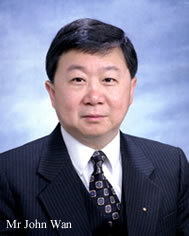PDG John Wan – Continuity – November 1999
Continuity
Are past presidents past?
(November 1999 Issue)
A past president was present at the private meeting with Governor Dipo Sani preceding his official visit to the club. He asked Governor Dipo and his delegation why many club presidents had become apparently dormant and inactive after their presidency. Some said they needed a very much deserved break; some lingered on for a while before they finally disappeared from the radar screen and into the oblivion; while some simply went into immediate hibernation. Still others left the club and Rotary and became members of the largest unorganized organization in the world ever, namely the organization of ex-Rotarians!
It may sound funny, except that it isn’t. It is not funny at all. This is serious business and the future of our movement could depend on whether we can bring back past presidents to our system and restore the very much needed continuity.
You have probably heard experienced Rotarians describing the importance to Rotary of each and every Rotarian. For recent literature reference, turn to page 24 of the Proceedings of the 38th District Conference of RI District 3450, where then RI Director Edgar C Hatcher Jr was recorded to have said that “the most important person in Rotary is the individual who does the work down in the trenches and gets the work done that elevates the quality of life of those people less fortunate.” Yes, Rotary does have high regard for every Rotarian, and quite rightly so, but Rotary International also attaches great importance to the leaders among Rotarians. To start with, a past president is also a Rotarian and hence by definition is much valued. In addition, RI would invest a lot more on him. Thus, every district governor must undergo vigorous and systematic training before he takes up office. This will not only ensure that he would do a good job during his governorship, but will also enable him to provide the mandatory training for his presidents and district officials. The system has been designed to put sufficient Rotary into every club president that would last him longer, much longer than the year of his presidency.
Now, all past presidents were presidents and by definition well trained and experienced Rotarians and leaders in Rotary. All of them had tasted the joy of successful service projects, fun and fellowship, and the love and support of their club members, perhaps some more than others though. They had been trained with their fellow presidents of their years by their respective governors to appreciate, interpret and impart the various Rotary themes and the Rotary ideal of service. In short, each and every past president is a tremendous asset, not only to his club, but also to the district and the Rotary world. To allow past presidents to become inactive is no different from putting valuable assets on ice and frozen, which no business and professional people worth their salt would even contemplate to do in the business world.
Past presidents have a lot to offer. They make excellent Rotary Foundation Committee chairmen, public relations consultants, bulletin editors, group leaders, trainers, mentors for young members, negotiators and advisors generally. Indeed, the immediate past president is often made in charge of organizing Rotary Information sessions. In short, they are adept in every job, for they have seen them all.
You may ask how the young members can gain the necessary experience if these past presidents continue with what they have been doing and doing so well. This is indeed a good question, and let me explain. First and foremost, being active does not necessarily mean taking up offices or retaining authority, including the power to veto club decisions. I go back to my favourite elements of leadership, leading and following. Effective leadership means being able to steer the club in the right direction and achieve the common objective. This is where seasoned leaders, namely past presidents, can do better than others. Past presidents can give the young members plenty of room to manoeuvre; allow them to lead and allow themselves to be led; watch over them without stifling them; lead them without directing them; and above all, motivate them to achieve and to lead.
On the other hand, younger members can also learn to appreciate the worth of past presidents and accord them the respect they deserve. They should have regard to the fact that these worthy men and women before them have individually or collectively helped build up the club and the district. They must understand that they are not there to compete with their predecessors or to outshine them. Above all, they are also club members. Thus, when they seek advice, they should do so with an open mind, rather than in a perfunctory manner. They would do better to dispense with the mindset about the old being ancient and the past being past. Very importantly, in the interest of continuity, they owe it to themselves and to the membership to explain why when they depart from well established practices and when they apparently ignore their predecessors’ advice.
Once again, continuity means all members working together towards the common objective of service; and keeping past presidents active helps.
ENDS

